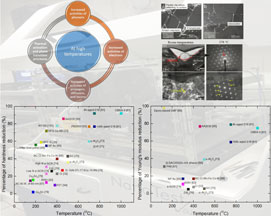Crossref Citations
This article has been cited by the following publications. This list is generated based on data provided by
Crossref.
Chavoshi, Saeed Zare
and
Xu, Shuozhi
2018.
Twinning effects in the single/nanocrystalline cubic silicon carbide subjected to nanoindentation loading.
Materialia,
Vol. 3,
Issue. ,
p.
304.
Chavoshi, Saeed Zare
and
Xu, Shuozhi
2018.
A Review on Micro- and Nanoscratching/Tribology at High Temperatures: Instrumentation and Experimentation.
Journal of Materials Engineering and Performance,
Vol. 27,
Issue. 8,
p.
3844.
Chavoshi, Saeed Zare
and
Xu, Shuozhi
2019.
Nanoindentation/scratching at finite temperatures: Insights from atomistic-based modeling.
Progress in Materials Science,
Vol. 100,
Issue. ,
p.
1.
Lin, P.H.
Chou, H.S.
Huang, J.C.
Chuang, W.S.
Jang, J.S.C.
and
Nieh, T.G.
2019.
Elevated-temperature creep of high-entropy alloys via nanoindentation.
MRS Bulletin,
Vol. 44,
Issue. 11,
p.
860.
Xu, Shuozhi
and
Chen, Xiang
2019.
Modeling dislocations and heat conduction in crystalline materials: atomistic/continuum coupling approaches.
International Materials Reviews,
Vol. 64,
Issue. 7,
p.
407.
Chavoshi, Saeed Z.
Tschopp, Mark A.
and
Branicio, Paulo S.
2019.
Transition of deformation mechanisms in nanotwinned single crystalline SiC.
Philosophical Magazine,
Vol. 99,
Issue. 21,
p.
2636.
Wu, Jili
Xu, Lin
and
Peng, Zhen
2019.
Structural gradient of plastic Fe50Ni30P13C7 bulk metallic glass.
Journal of Alloys and Compounds,
Vol. 788,
Issue. ,
p.
118.
Liu, Kui
Wang, Hao
and
Zhang, Xinquan
2020.
Ductile Mode Cutting of Brittle Materials.
p.
255.
Liu, Hao
Yu, Long
and
Xiao, Xiazi
2020.
Hardness-Depth Relationship with Temperature Effect for Single Crystals—A Theoretical Analysis.
Crystals,
Vol. 10,
Issue. 2,
p.
112.
Jian, Wu-Rong
Zhang, Min
Xu, Shuozhi
and
Beyerlein, Irene J.
2020.
Atomistic simulations of dynamics of an edge dislocation and its interaction with a void in copper: a comparative study.
Modelling and Simulation in Materials Science and Engineering,
Vol. 28,
Issue. 4,
p.
045004.
Liu, Qi
Liao, Zhirong
and
Axinte, Dragos
2020.
Temperature effect on the material removal mechanism of soft-brittle crystals at nano/micron scale.
International Journal of Machine Tools and Manufacture,
Vol. 159,
Issue. ,
p.
103620.
Hull, Katherine L.
and
Abousleiman, Younane N.
2021.
SEM analysis of pop-ins manifested in layered porous geological material.
MRS Communications,
Vol. 11,
Issue. 6,
p.
747.
Guan, Qingwen
Lu, Wenjun
and
He, Binbin
2021.
Recent Progress in Understanding the Nano/Micro-Mechanical Behavior of Austenite in Advanced High Strength Steels.
Metals,
Vol. 11,
Issue. 12,
p.
1927.
Liu, Xunda
Tatsumi, Hiroaki
Jin, Zhi
Chen, Zhong
and
Nishikawa, Hiroshi
2023.
Thermomechanical Properties of Zeta (Ag3In) Phase.
Materials,
Vol. 16,
Issue. 22,
p.
7115.
Steffen, Raphael Timothy
Tucker, Michael Robert
Sillani, Francesco
Schütz, Denis
and
Bambach, Markus
2024.
Correlation analysis of feedstock flowability and temperature for laser-based powder bed fusion of polymers.
Rapid Prototyping Journal,
Vol. 30,
Issue. 10,
p.
2043.
Sarkar, Prakash
Pant, Prita
and
Nanavati, Hemant
2024.
Physical phenomena during nanoindentation deformation of amorphous glassy polymers.
Polymer,
Vol. 312,
Issue. ,
p.
127597.
Shen, Ziyi
Su, Yutai
Liang, Zhiyuan
and
Long, Xu
2024.
Review of indentation size effect in crystalline materials: Progress, challenges and opportunities.
Journal of Materials Research and Technology,
Vol. 31,
Issue. ,
p.
117.
Nene, Saurabh S.
2024.
High Entropy Alloys.
p.
193.
Feng, Yulong
Fang, Ruihan
Li, Renjie
Li, Kai
and
Cui, Yuhong
2025.
Thermoelastoplastic contact and charge characteristics of nonrotationally symmetric lunar dust particles.
Powder Technology,
Vol. 452,
Issue. ,
p.
120599.
Wang, Yunpeng
Rao, Qijian
Wu, Yueqin
Huang, Hui
and
Xu, Xipeng
2025.
Unveiling the temperature-dependent deformation mechanisms of single crystal gallium nitride in nanoscratching.
Applied Surface Science,
Vol. 682,
Issue. ,
p.
161606.


